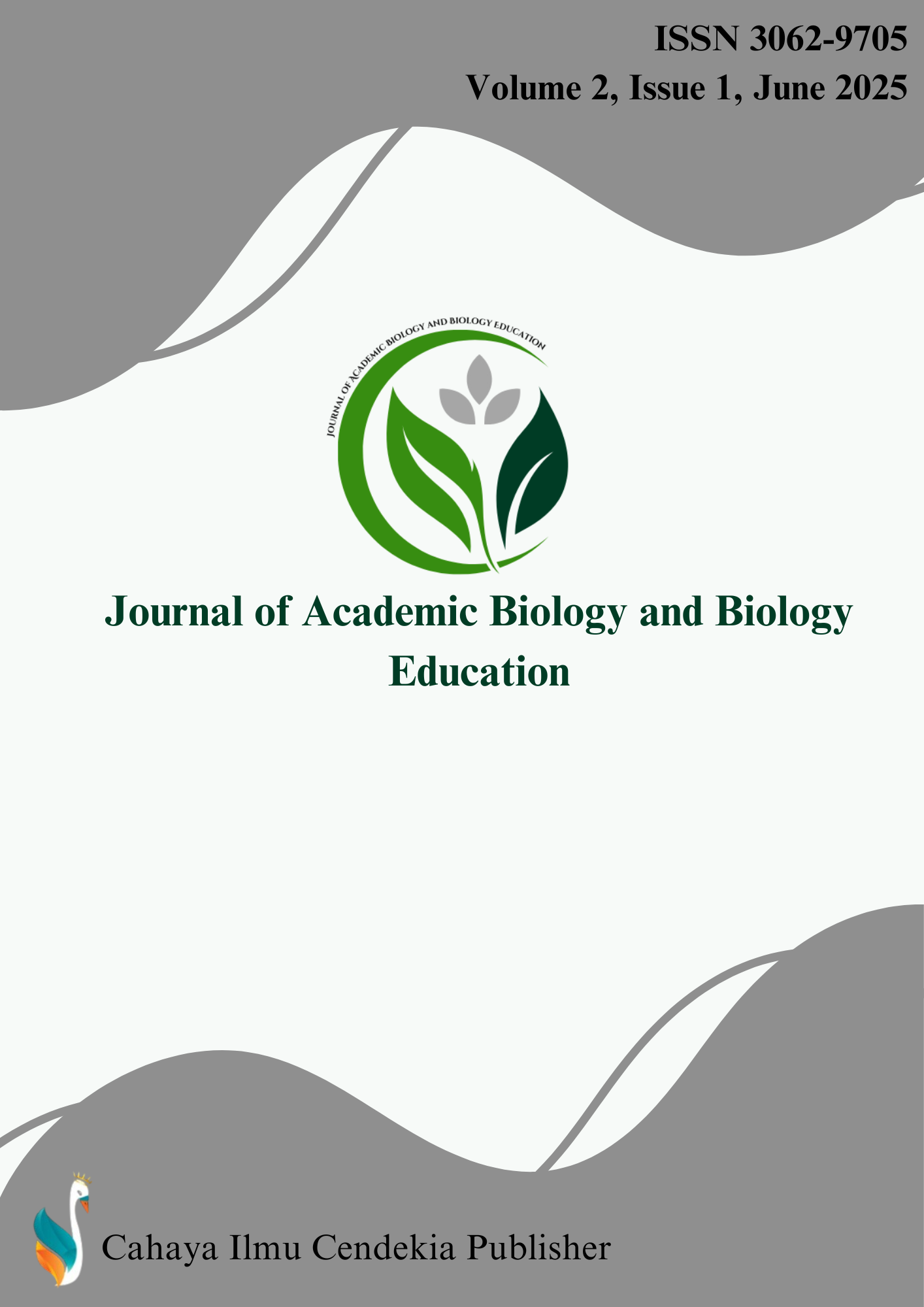Teratogenic Effects of Ethanolic Cinnamomum burmanni Leaf Extract on Fetal Development in White Mice (Mus musculus L.)
Abstract
Purpose of the study: This study aims to evaluate the teratogenic effects of ethanolic extract of Cinnamomum burmanni leaves on fetal development in white mice (Mus musculus L.).
Methodology: This research is a laboratory experimental study using a Completely Randomized Design (CRD) and a pretest-posttest control group design. A total of 24 pregnant female mice were divided into four treatment groups: negative control (Na CMC), P1 (250 mg/kgBW), P2 (500 mg/kgBW), and P3 (1000 mg/kgBW). The extract was administered orally during the organogenesis period. Observed parameters included fetal weight and length, morphological abnormalities, hemorrhage, ossification, and resorption sites. Data were analyzed using One-Way ANOVA followed by Duncan’s test.
Main Findings: The results of the study showed that administration of ethanolic extract of Cinnamomum burmanni leaves significantly (p < 0.05) reduced fetal weight and length, and induced morphological abnormalities and hemorrhage at doses of 250 mg/kgBW and above. However, no abnormalities were observed in the ossification process or resorption sites.
Novelty/Originality of this study: The ethanolic extract of Cinnamomum burmanni leaves demonstrated potential teratogenic effects on fetal development in white mice, characterized by growth retardation and morphological abnormalities. This study provides an important basis for evaluating the safety of using this plant during pregnancy.
References
L. Tariq, B. A. Bhat, S. S. Hamdani, and R. A. Mir, “Phytochemistry, Pharmacology and Toxicity of Medicinal Plants BT - Medicinal and Aromatic Plants: Healthcare and Industrial Applications,” T. Aftab and K. R. Hakeem, Eds., Cham: Springer International Publishing, 2021, pp. 217–240. doi: 10.1007/978-3-030-58975-2_8.
S. Alam et al., “Antidiabetic phytochemicals from medicinal plants: prospective candidates for new drug discovery and development,” Front. Endocrinol. (Lausanne)., vol. 13, no. February, 2022, doi: 10.3389/fendo.2022.800714.
D. C. P. Sousa, W. S. Ferreira Júnior, and U. P. Albuquerque, “Short-term temporal analysis and children’s knowledge of the composition of important medicinal plants: the structural core hypothesis,” J. Ethnobiol. Ethnomed., vol. 18, no. 1, pp. 1–15, 2022, doi: 10.1186/s13002-022-00548-2.
A. Ouma, “Intergenerational learning processes of traditional medicinal knowledge and socio-spatial transformation dynamics,” Front. Sociol., vol. 7, no. July, pp. 1–10, 2022, doi: 10.3389/fsoc.2022.661992.
R. A. Permadi, N. Nurdebyandaru, and A. Wahyudi, “Developing sustainable smallholders of cinnamon by intercropping of patchouli and coffee in Kerinci, Jambi,” IOP Conf. Ser. Earth Environ. Sci., vol. 648, no. 1, 2021, doi: 10.1088/1755-1315/648/1/012069.
P. Kievit, M. Schoorl, J. Oomes, and P. Bartels, “Quality innovation in healthcare – the challenge of the third era,” Eur. J. Nat. Sci. Med., vol. 4, no. 2, pp. 79–99, 2021, doi: 10.26417/303oix63f.
T. Estiasih et al., “Indonesian traditional herbal drinks: diversity, processing, and health benefits,” J. Ethn. Foods, vol. in Review, 2024, doi: 10.1186/s42779-025-00267-5.
J. Kowalska, J. Tyburski, K. Matysiak, M. Jakubowska, J. Łukaszyk, and J. Krzymińska, “Cinnamon as a useful preventive substance for the care of human and plant health,” Molecules, vol. 26, no. 17, pp. 1–13, 2021, doi: 10.3390/molecules26175299.
D. Setyorini and S. S. Antarlina, “Secondary metabolites in sorghum and its characteristics,” Food Sci. Technol., vol. 42, 2022, doi: 10.1590/fst.49822.
A. Sharma, S. Sharma, A. Kumar, V. Kumar, and A. K. Sharma, “Plant Secondary Metabolites: An Introduction of Their Chemistry and Biological Significance with Physicochemical Aspect BT - Plant Secondary Metabolites: Physico-Chemical Properties and Therapeutic Applications,” A. K. Sharma and A. Sharma, Eds., Singapore: Springer Nature Singapore, 2022, pp. 1–45. doi: 10.1007/978-981-16-4779-6_1.
R. Sivaranjani, T. J. Zachariah, and N. K. Leela, “Phytotherapeutic potential of bi-herbal extract of cinnamon and turmeric: in vivo antidiabetic studies,” Clin. Phytoscience, vol. 7, no. 1, p. 38, 2021, doi: 10.1186/s40816-021-00275-3.
C. Laçin, D. O. Turhan, and A. Güngördü, “Assessing the impact of antiviral drugs commonly utilized during the COVID-19 pandemic on the embryonic development of Xenopus laevis,” J. Hazard. Mater., vol. 472, p. 134462, 2024, doi: https://doi.org/10.1016/j.jhazmat.2024.134462.
A. M. Calado, F. Seixas, and M. dos A. Pires, “Updating an overview of teratology BT - teratogenicity testing: methods and protocols,” L. Félix, Ed., New York, NY: Springer US, 2024, pp. 1–38. doi: 10.1007/978-1-0716-3625-1_1.
B. Peng, Q. Dong, F. Li, T. Wang, X. Qiu, and T. Zhu, “A systematic review of polycyclic aromatic hydrocarbon derivatives: occurrences, levels, biotransformation, exposure biomarkers, and toxicity,” Environ. Sci. Technol., vol. 57, no. 41, pp. 15314–15335, Oct. 2023, doi: 10.1021/acs.est.3c03170.
H. P. Barrier, I. Kotta-loizou, A. Pritsa, G. Antasouras, S. N. Vasilopoulos, and G. Voulgaridou, “Fetus exposure to drugs and chemicals: a holistic overview on the assessment of their transport and metabolism across the human placental barrier,” Disiases, vol. 12, p. 114, 2024.
J. J. Adibi et al., “First trimester mechanisms of gestational sac placental and foetal teratogenicity: a framework for birth cohort studies,” Hum. Reprod. Update, vol. 27, no. 4, pp. 747–770, 2021, doi: 10.1093/humupd/dmaa063.
D. A. Smith, “Teratogenicity is more likely a function of primary and secondary pharmacology than caused by chemically reactive metabolites: a critical evaluation of 40 years of scientific research,” Xenobiotica, vol. 54, no. 9, pp. 599–608, Oct. 2024, doi: 10.1080/00498254.2024.2366302.
N. Bernstein, M. Akram, Z. Yaniv-Bachrach, and M. Daniyal, “Is it safe to consume traditional medicinal plants during pregnancy?,” Phyther. Res., vol. 35, no. 4, pp. 1908–1924, 2021, doi: 10.1002/ptr.6935.
M. Masjedi, Y. Izadi, T. Montahaei, R. Mohammadi, M. Ali Helforoush, and K. Rohani Rad, “An illustrated review on herbal medicine used for the treatment of female infertility,” Eur. J. Obstet. Gynecol. Reprod. Biol., vol. 302, pp. 273–282, 2024, doi: https://doi.org/10.1016/j.ejogrb.2024.09.028.
K. Vijayakumar et al., “Acute toxicity studies and protective effects of Cinnamon cassia bark extract in streptozotocin-induced diabetic rats,” Drug Chem. Toxicol., vol. 45, no. 5, pp. 2086–2096, Sep. 2022, doi: 10.1080/01480545.2021.1907908.
J. Ju, M. Santana de Oliveira, and Y. Qiao, “Safety evaluation of cinnamon or cinnamon extract BT - cinnamon: a medicinal plant and a functional food systems,” J. Ju, M. Santana de Oliveira, and Y. Qiao, Eds., Cham: Springer International Publishing, 2023, pp. 247–257. doi: 10.1007/978-3-031-33505-1_17.
M. Ahmad et al., “Safety assessment of standardised methanol extract of Cinnamomum burmannii,” Phytomedicine, vol. 20, no. 12, pp. 1124–1130, Sep. 2013, doi: 10.1016/j.phymed.2013.05.005.
B. Sarecka-Hujar and B. Szulc-Musioł, “Herbal medicines—are they effective and safe during pregnancy?,” Pharmaceutics, vol. 14, no. 1, p. 171, Jan. 2022, doi: 10.3390/pharmaceutics14010171.
M. K. Balijepalli, A. S. Buru, R. Sakirolla, and M. R. Pichika, “Cinnamomum Genus: a review on its biological activities,” Int. J. Pharm. Pharm. Sci., vol. 9, no. 2, pp. 1–11, 2017, doi: 10.22159/ijpps.2017v9i2.11156.
Y. Ayhan and E. Akalın Uruşak, “Evaluation of herbal medicine use in the obstetric and gynecology department,” İstanbul J. Pharm., vol. 51, no. 2, pp. 243–255, Aug. 2021, doi: 10.26650/IstanbulJPharm.2020.0064.
F. Husna, S. Suhaila, D. Syahrizal, Z. Zulkarnain, H. Washilah, and A. P. Sahriana, “Antioxidant potential, anti-diabetes, and toxicity of Aceh cinnamon extract (Cinnamomum burmannii),” Indones. J. Pharm. Sci. Technol., vol. 11, no. 1, 2024, doi: 10.24198/ijpst.v11i1.43182.
A. M. A. Nazareno, L. Purnamasari, and J. F. Dela Cruz, “In vivo and In vitro anti-diabetic effects of cinnamon (Cinnamomum sp.) plant extract: A review,” Canrea J. Food Technol. Nutr. Culin. J., vol. 5, no. 2, pp. 151–171, 2022, doi: 10.20956/canrea.v5i2.673.
D. Ardilla, M. Taufik, K. Rangkuti, M. Razali, and Z. I. Fauzi, “Completely randomized design (CRD) method on lard analysis which was adulterated to palm oil,” 2023, p. 150001. doi: 10.1063/5.0136090.
J. Salinas Ruíz, O. A. Montesinos López, and J. Crossa, “Completely Random Design BT - Introduction to Experimental Designs with PROC GLIMMIX of SAS: Applications in Food Science and Agricultural Science,” J. Salinas Ruíz, O. A. Montesinos López, and J. Crossa, Eds., Cham: Springer Nature Switzerland, 2024, pp. 11–56. doi: 10.1007/978-3-031-65575-3_2.
K. Gupta, “Research Design and Methods in Social Sciences Research,” 2023, pp. 94–116. doi: 10.4018/978-1-6684-6859-3.ch007.
C. G. Thomas, “Experimental Research BT - Research Methodology and Scientific Writing,” C. G. Thomas, Ed., Cham: Springer International Publishing, 2021, pp. 93–133. doi: 10.1007/978-3-030-64865-7_5.
M. J. Barnett, S. Doroudgar, V. Khosraviani, and E. J. Ip, “Multiple comparisons: to compare or not to compare, that is the question,” Res. Soc. Adm. Pharm., vol. 18, no. 2, pp. 2331–2334, 2022, doi: https://doi.org/10.1016/j.sapharm.2021.07.006.
C. E. Agbangba, E. Sacla Aide, H. Honfo, and R. Glèlè Kakai, “On the use of post-hoc tests in environmental and biological sciences: a critical review,” Heliyon, vol. 10, no. 3, p. e25131, 2024, doi: 10.1016/j.heliyon.2024.e25131.
H. Gad El-Hak and M. Gerges, “Evaluating the teratogenic effect of Eugenol in the development of the chick embryos,” J. Biol. Stud., vol. 1, no. 2, pp. 59–75, Jun. 2018, doi: 10.62400/jbs.v1i2.13.
P. Djarot et al., “Bioactivities and Chemical Compositions of Cinnamomum burmannii bark extracts (Lauraceae),” Sustain., vol. 15, no. 2, 2023, doi: 10.3390/su15021696.
M. Pitaro, N. Croce, V. Gallo, A. Arienzo, G. Salvatore, and G. Antonini, “Coumarin-induced hepatotoxicity : a narrative review,” Molecules, vol. 27, no. 9063, pp. 1–20, 2022, doi: 10.3390/molecules27249063.
M. Safithri, S. Yasni, M. Bintang, and A. S. Ranti, “Toxicity study of antidiabetics functional drink piper crocatum and Cinnamomum burmannii,” HAYATI J. Biosci., vol. 19, no. 1, pp. 31–36, Mar. 2012, doi: 10.4308/hjb.19.1.31.
N. S. Dosoky and W. N. Setzer, “Maternal reproductive toxicity of some essential oils and their constituents,” Int. J. Mol. Sci., vol. 22, no. 5, p. 2380, Feb. 2021, doi: 10.3390/ijms22052380.
A. D. Kharisma, U. C. Nisa, and Yasman, “Evaluation of antioxidant activity and toxicity of Cinnamomum Burmannii B. from different provinces of Indonesia,” J. Hunan Univ. Nat. Sci., vol. 50, no. 4, 2023, doi: 10.55463/issn.1674-2974.50.4.16.
G. Chamorro-Cevallos et al., “A complete review of mexican plants with teratogenic effects,” Plants, vol. 11, no. 13, pp. 1–27, 2022, doi: 10.3390/plants11131675.
Copyright (c) 2025 Zeynab Noroozi, Jose Dale Viacrucis Iii, Khenchil Amir

This work is licensed under a Creative Commons Attribution 4.0 International License.
Authors who publish with this journal agree to the following terms:
- Authors retain copyright and acknowledge that the Journal of Academic Biology and Biology Education is the first publisher licensed under a Creative Commons Attribution 4.0 International License.
- Authors are able to enter into separate, additional contractual arrangements for the non-exclusive distribution of the journal's published version of the work (e.g., post it to an institutional repository or publish it in a book), with an acknowledgment of its initial publication in this journal.
- Authors are permitted and encouraged to post their work online (e.g., in institutional repositories or on their website) prior to and during the submission process, as it can lead to productive exchanges and earlier and greater citation of published work.



.png)

.png)
.png)








